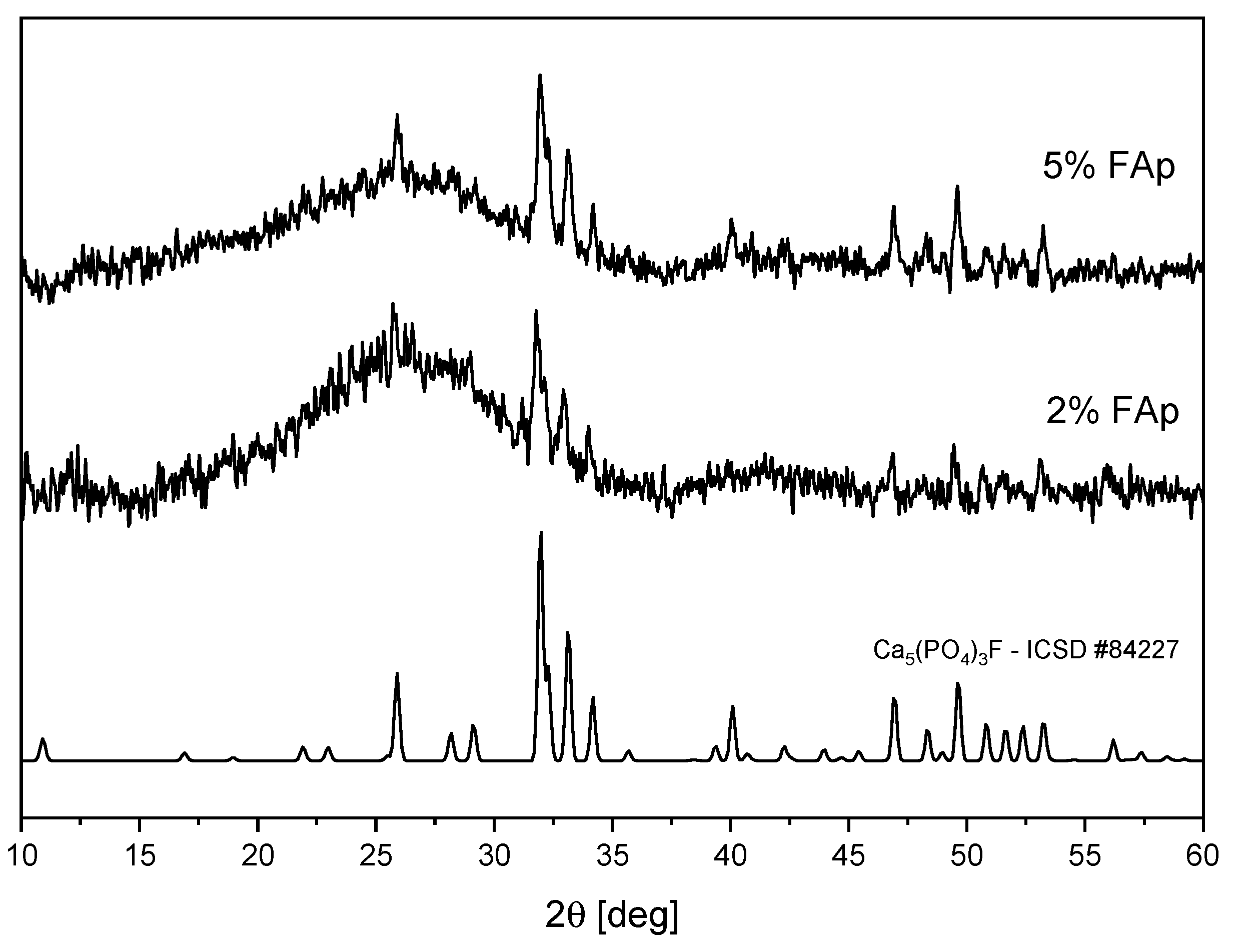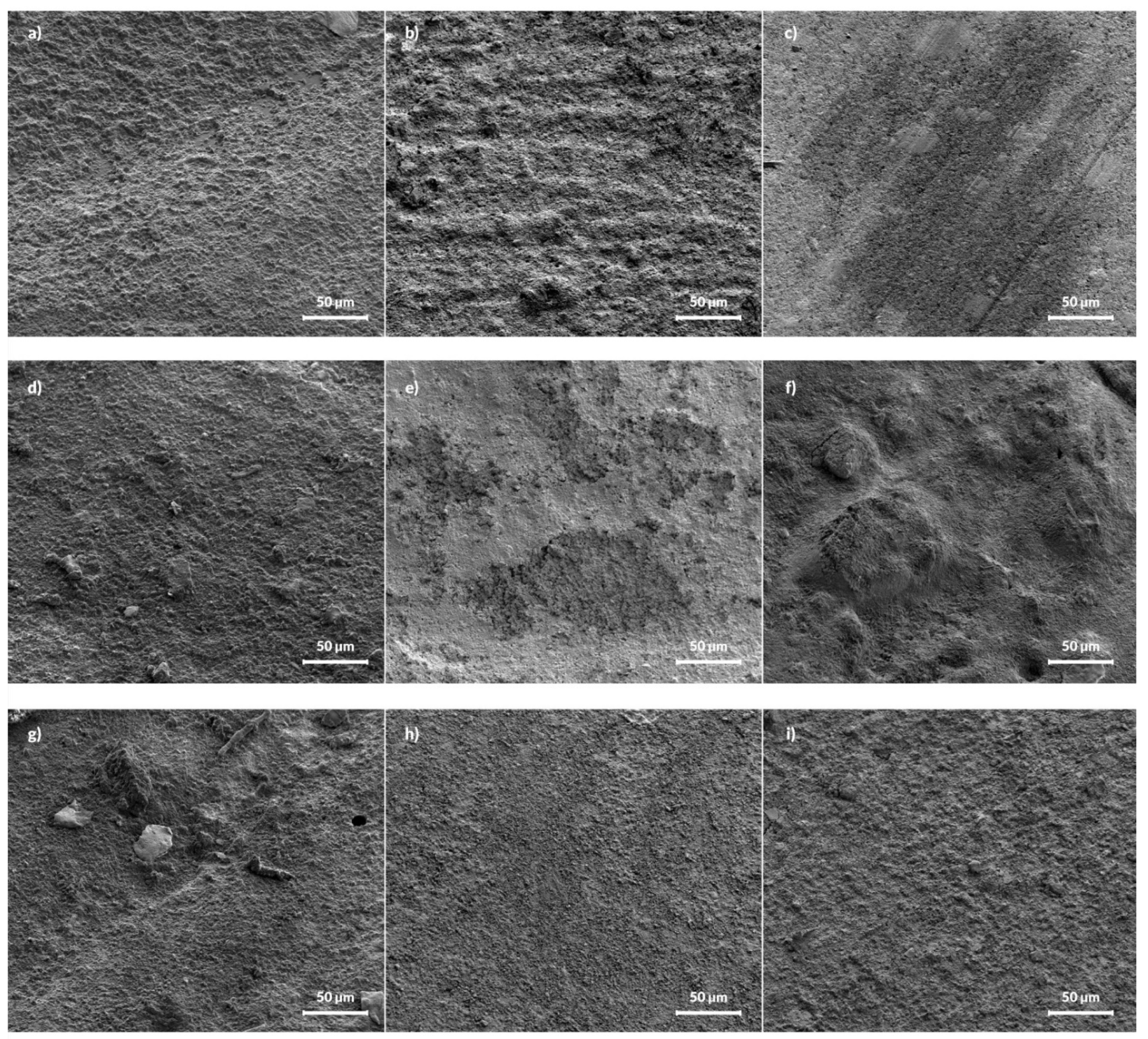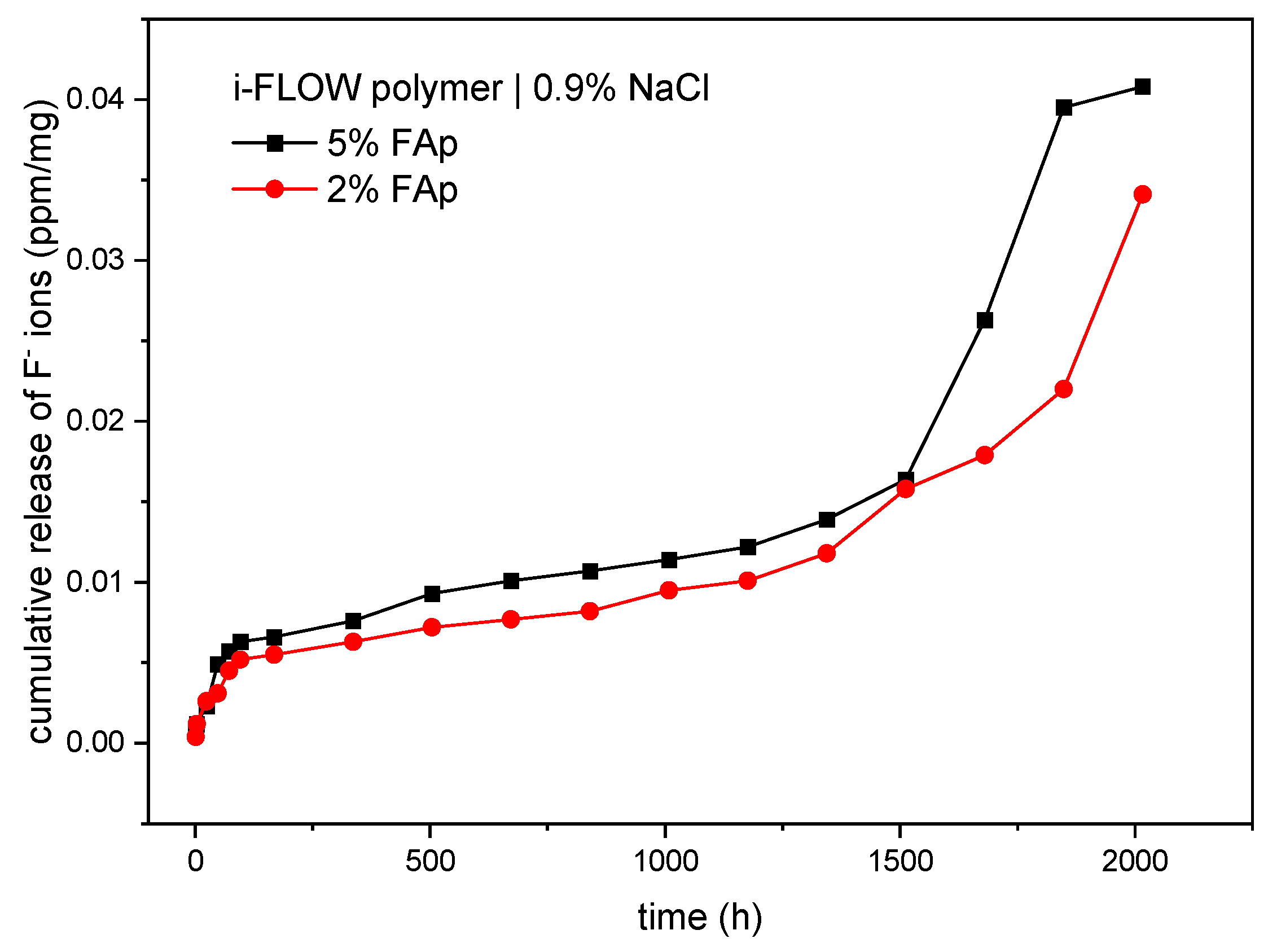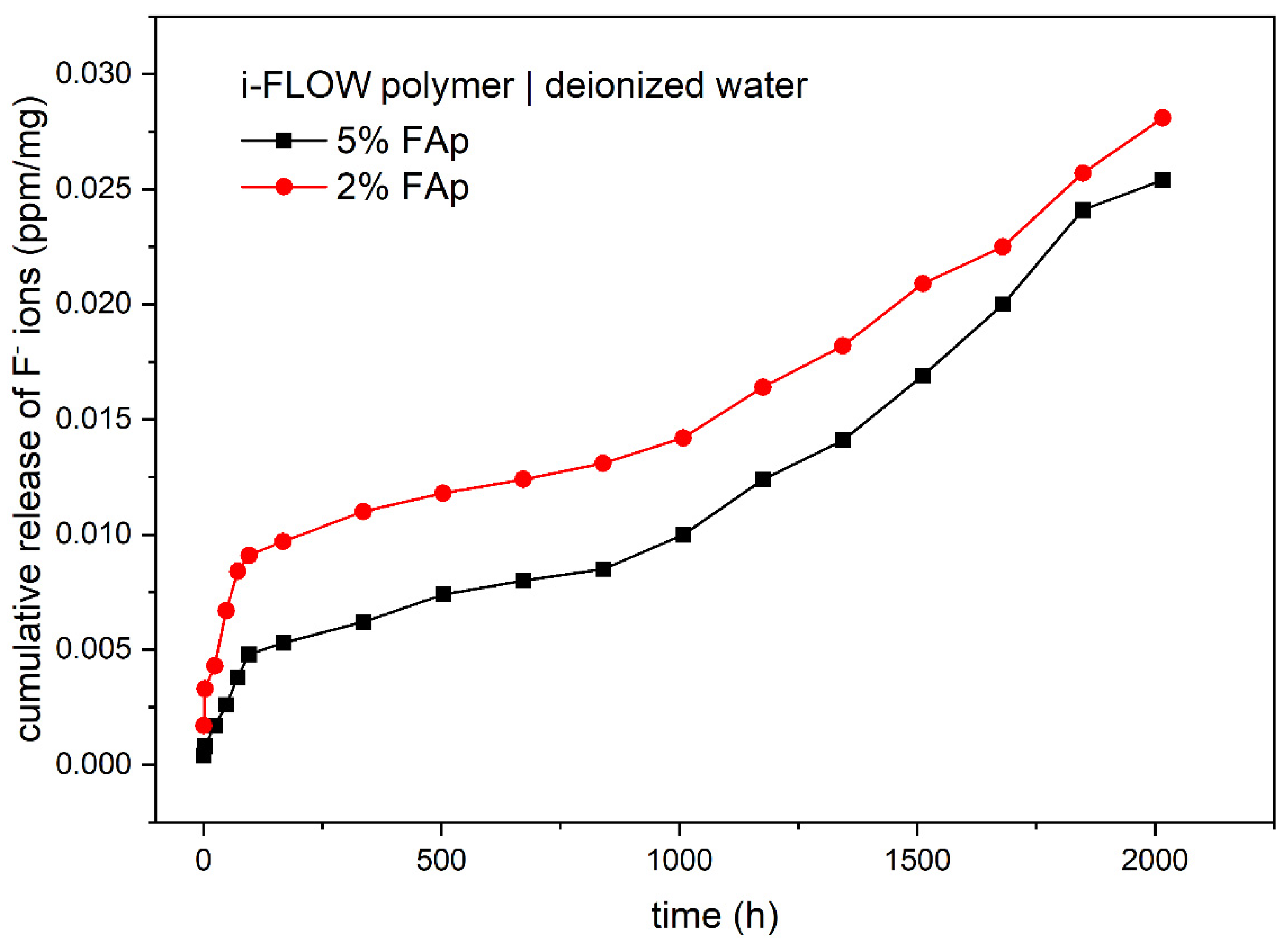In Vitro Studies concerning Selected Properties of a Composite Material Blended with Nanofluoroapatite Crystals
Abstract
:1. Introduction
2. Materials and Methods
- i-FLOW (i-dental, Siauliai, Lithuania): a light-curing, nano, flowable, radiopaque composite, under the Vita shades, based on Barium glass filler and EOBPADMA, UDMA, Bis-GMA, TEGDMA resins.
- Nanofluoroapatite: The nanocrystalline powder of fluorapatite was prepared by a co-precipitation method. Analytical-grade Ca(NO3)2·4H2O (99+%, Acros Organics, Geel, Belgium), NH4H2PO4 (99.995%, Alfa Aesar, Haverhill, MA, USA), NH4F (98%, Alfa Aesar, Haverhill, MA, USA), and NH3 ·H2O (99%, Avantor, Gliwice, Poland) were used as starting substrates and for pH adjustment. Subsequently, calcium nitrate was dissolved in deionized water, and then suitable amounts of ammonium phosphate dibasic and then ammonium fluoride were added to the mixture leading to fast precipitation of the by-product. The pH of the dispersion was modulated to 8–9 by adding ammonia, then the suspension was heated and stirred on a stirring plate for 3 h. Finally, the obtained product was centrifuged, rinsed with de-ionized water several times, dried at 70 °C for 24 h, and heat-treated at 450 °C for 6 h to obtain nanofluoroapatites.
3. Results
4. Discussion
5. Conclusions
Author Contributions
Funding
Institutional Review Board Statement
Informed Consent Statement
Data Availability Statement
Acknowledgments
Conflicts of Interest
References
- Staszczyk, M.; Kępisty, M.; Kołodziej, I.; Kościelniak, D.; Gregorczyk-Maga, I.; Ciepły, J.; Jurczak, A. Dental Caries Status and Trend in 5-, 7- and 12-Year-Old Children from the Małopolskie Region in Comparison to the Polish Population. Nowa Stomatol. 2018, 23, 55–65. [Google Scholar] [CrossRef]
- Mathur, V.P.; Dhillon, J.K. Dental Caries: A Disease Which Needs Attention. Indian J. Pediatrics 2018, 85, 202–206. [Google Scholar] [CrossRef] [PubMed]
- Lynch, R.M.; Navada, R.; Walia, R. Low-Levels of Fluoride in Plaque and Saliva and Their Effects on the Demineralisation and Remineralisation of Enamel; Role of Fluoride Toothpastes. Int. Dent. J. 2004, 54, 304–309. [Google Scholar] [CrossRef] [PubMed]
- Kaczmarek, U. The Cariostatic Mechanisms of Fluoride. Czas. Stomatol. 2005, 58, 404–413. [Google Scholar]
- Kaczmarek, U. Fluoride Release from Dental Restorative Materials and Secondary Caries. Dent. Med Probl. 2005, 42, 333–340. [Google Scholar]
- Hicks, J.; Garcia-Godoy, F.; Donly, K.; Flaitz, C. Fluoride-Releasing Restorative Materials and Secondary Caries. J. Calif. Dent. Assoc. 2003, 31, 229–245. [Google Scholar] [CrossRef]
- Fita, K.; Dobrzyński, M.; Ziętek, M.; Diakowska, D.; Watras, A.; Wiglusz, R.J. Assessment of Microstructure and Release of Fluoride Ions from Selected Fissure Sealants: An In Vitro Study. Materials 2021, 14, 4936. [Google Scholar] [CrossRef]
- Arends, J.; Dijkman, G.E.H.M.; Dijkman, A.G. Review of Fluoride Release and Secondary Caries Reduction by Fluoridating Composites. Adv. Dent. Res. 1995, 9, 367–376. [Google Scholar] [CrossRef]
- Forss, H.; Seppä, L. Studies on the Effect of Fluoride Released by Glass Ionomers in the Oral Cavity. Adv. Dent. Res. 1995, 9, 389–393. [Google Scholar] [CrossRef]
- Tiwari, A.P.; Joshi, M.K.; Maharjan, B.; Ko, S.W.; Kim, J.I.; Park, C.H.; Kim, C.S. Engineering a Novel Bilayer Membrane for Bone Defects Regeneration. Mater. Lett. 2016, 180, 268–272. [Google Scholar] [CrossRef]
- Zakrzewski, W.; Dobrzynski, M.; Rybak, Z.; Szymonowicz, M.; Wiglusz, R.J. Selected Nanomaterials’ Application Enhanced with the Use of Stem Cells in Acceleration of Alveolar Bone Regeneration during Augmentation Process. Nanomaterials 2020, 10, 1216. [Google Scholar] [CrossRef]
- Kim, J.H.; Unnithan, A.R.; Kim, H.J.; Tiwari, A.P.; Park, C.H.; Kim, C.S. Electrospun Badger (Meles Meles) Oil/Ag Nanoparticle Based Anti-Bacterial Mats for Biomedical Applications. J. Ind. Eng. Chem. 2015, 30, 254–260. [Google Scholar] [CrossRef]
- Lubojanski, A.; Dobrzynski, M.; Nowak, N.; Rewak-Soroczynska, J.; Sztyler, K.; Zakrzewski, W.; Dobrzynski, W.; Szymonowicz, M.; Rybak, Z.; Wiglusz, K.; et al. Application of Selected Nanomaterials and Ozone in Modern Clinical Dentistry. Nanomaterials 2021, 11, 259. [Google Scholar] [CrossRef] [PubMed]
- Rošin-Grget, K. The Cariostatic Mechanisms of Fluoride. Acta Med. Acad. 2013, 42, 179–188. [Google Scholar] [CrossRef] [PubMed] [Green Version]
- Bahl, S.; Nagar, H.; Singh, I.; Sehgal, S. Smart Materials Types, Properties and Applications: A Review. Mater. Today: Proc. 2020, 28, 1302–1306. [Google Scholar] [CrossRef]
- Moothedath, M.; Moothedath, M.; Jairaj, A.; Harshitha, B.; Harshitha, B.; Baba, S.M.; Khateeb, S.U. Role of Nanotechnology in Dentistry: Systematic Review. J. Int. Soc. Prev. Community Dent. 2019, 9, 535. [Google Scholar] [CrossRef]
- Maman, P.; Nagpal, M.; Gilhotra, R.M.; Aggarwal, G. Nano Era of Dentistry-An Update. Curr. Drug Deliv. 2018, 15, 186–204. [Google Scholar] [CrossRef]
- Sharan, J.; Singh, S.; Lale, S.V.; Mishra, M.; Koul, V.; Kharbanda, O.P. Applications of Nanomaterials in Dental Science: A Review. J. Nanosci. Nanotechnol. 2017, 17, 2235–2255. [Google Scholar] [CrossRef]
- Bordea, I.R.; Candrea, S.; Alexescu, G.T.; Bran, S.; Băciuț, M.; Băciuț, G.; Lucaciu, O.; Dinu, C.M.; Todea, D.A. Nano-Hydroxyapatite Use in Dentistry: A Systematic Review. Drug Metab. Rev. 2020, 52, 319–332. [Google Scholar] [CrossRef]
- Vasiliu, S.; Racovita, S.; Gugoasa, I.A.; Lungan, M.-A.; Popa, M.; Desbrieres, J. The Benefits of Smart Nanoparticles in Dental Applications. Int. J. Mol. Sci. 2021, 22, 2585. [Google Scholar] [CrossRef]
- Kovvuru, S.K.; Mahita, V.N.; Manjunatha, B.; Babu, B.S. Nanotechnology: The Emerging Science in Dentistry. J. Orofac. Res. 2012, 2, 33–36. [Google Scholar]
- Khurshid, Z.; Zafar, M.; Qasim, S.; Shahab, S.; Naseem, M.; AbuReqaiba, A. Advances in Nanotechnology for Restorative Dentistry. Materials 2015, 8, 717. [Google Scholar] [CrossRef] [Green Version]
- Freitas, R.A. Nanodentistry. J. Am. Dent. Assoc. 2000, 131, 1559–1565. [Google Scholar] [CrossRef]
- Peralta, S.L.; de Leles, S.B.; Dutra, A.L.; da Guimaraes, V.B.S.; Piva, E.; Lund, R.G. Evaluation of Physical-Mechanical Properties, Antibacterial Effect, and Cytotoxicity of Temporary Restorative Materials. J. Appl. Oral Sci. 2018, 26, 1–10. [Google Scholar] [CrossRef]
- Peskersoy, C.; Culha, O. Comparative Evaluation of Mechanical Properties of Dental Nanomaterials. J. Nanomater. 2017, 2017, 1–8. [Google Scholar] [CrossRef]
- Pecho, O.E.; Ghinea, R.; do Amaral, E.A.N.; Cardona, J.C.; della Bona, A.; Pérez, M.M. Relevant Optical Properties for Direct Restorative Materials. Dent. Mater. 2016, 32, e105–e112. [Google Scholar] [CrossRef] [PubMed]
- Chen, M.; Jiang, D.; Li, D.; Zhu, J.; Li, G.; Xie, J. Controllable Synthesis of Fluorapatite Nanocrystals with Various Morphologies: Effects of PH Value and Chelating Reagent. J. Alloy. Compd. 2009, 485, 396–401. [Google Scholar] [CrossRef]
- Chinthaka Silva, G.W.; Ma, L.; Hemmers, O.; Lindle, D. Micro-Structural Characterization of Precipitation-Synthesized Fluorapatite Nano-Material by Transmission Electron Microscopy Using Different Sample Preparation Techniques. Micron 2008, 39, 269–274. [Google Scholar] [CrossRef] [PubMed]
- Wang, H.; Sun, K.; Li, A.; Wang, W.; Chui, P. Size-Controlled Synthesis and Characterization of Fluorapatite Nanocrystals in the Presence of Gelatin. Powder Technol. 2011, 209, 9–14. [Google Scholar] [CrossRef]
- Herman, K.; Wujczyk, M.; Dobrzynski, M.; Diakowska, D.; Wiglusz, K.; Wiglusz, R.J. In Vitro Assessment of Long-Term Fluoride Ion Release from Nanofluorapatite. Materials 2021, 14, 3747. [Google Scholar] [CrossRef] [PubMed]
- Khaghani, M.; Alizadeh, S.; Doostmohammadi, A. Influence of Incorporating Fluoroapatite Nanobioceramic on the Compressive Strength and Bioactivity of Glass Ionomer Cement. J. Dent. Biomater. 2016, 3, 276–283. [Google Scholar] [PubMed]
- Ebrahimi-Kahrizsangi, R.; Nasiri-Tabrizi, B.; Chami, A. Characterization of Single-Crystal Fluorapatite Nanoparticles Synthesized via Mechanochemical Method. Particuology 2011, 9, 537–544. [Google Scholar] [CrossRef]
- Moshaverinia, A.; Ansari, S.; Moshaverinia, M.; Roohpour, N.; Darr, J.A.; Rehman, I. Effects of Incorporation of Hydroxyapatite and Fluoroapatite Nanobioceramics into Conventional Glass Ionomer Cements (GIC). Acta Biomater. 2008, 4, 432–440. [Google Scholar] [CrossRef]
- Moshaverinia, A.; Ansari, S.; Movasaghi, Z.; Billington, R.W.; Darr, J.A.; Rehman, I.U. Modification of Conventional Glass-Ionomer Cements with N-Vinylpyrrolidone Containing Polyacids, Nano-Hydroxy and Fluoroapatite to Improve Mechanical Properties. Dent. Mater. 2008, 24, 1381–1390. [Google Scholar] [CrossRef]
- Shinonaga, Y.; Arita, K.; Nishimura, T.; Chiu, S.-Y.; Chiu, H.-H.; Abe, Y.; Sonomoto, M.; Harada, K.; Nagaoka, N. Effects of Porous-Hydroxyapatite Incorporated into Glass-Ionomer Sealants. Dent. Mater. J. 2015, 34, 196–202. [Google Scholar] [CrossRef] [Green Version]
- Vano, M.; Derchi, G.; Barone, A.; Covani, U. Effectiveness of Nano-Hydroxyapatite Toothpaste in Reducing Dentin Hypersensitivity: A Double-Blind Randomized Controlled Trial. Quintessence Int. 2014, 45, 703–711. [Google Scholar] [CrossRef]
- Wang, L.; Magalhães, A.; Francisconi-dos-Rios, L.; Calabria, M.; Araújo, D.; Buzalaf, M.; Lauris, J.; Pereira, J. Treatment of Dentin Hypersensitivity Using Nano-Hydroxyapatite Pastes: A Randomized Three-Month Clinical Trial. Oper. Dent. 2016, 41, E93–E101. [Google Scholar] [CrossRef] [Green Version]
- Amaechi, B.T.; Lemke, K.C.; Saha, S.; Gelfond, J. Clinical Efficacy in Relieving Dentin Hypersensitivity of Nanohydroxyapatite-Containing Cream: A Randomized Controlled Trial. Open Dent. J. 2018, 12, 572–585. [Google Scholar] [CrossRef]
- Yaberi, M.; Haghgoo, R. A Comparative Study of the Effect of Nanohydroxyapatite and Eggshell on Erosive Lesions of the Enamel of Permanent Teeth Following Soft Drink Exposure: A Randomized Clinical Trial. J. Int. Oral Health 2018, 10, 176. [Google Scholar] [CrossRef]
- Marczuk-Kolada, G.; Jakoniuk, P.; Mystkowska, J.; Łuczaj-Cepowicz, E.; Waszkiel, D.; Dabrowski, J.R.; Leszczyńska, K. Fluoride Release and Antibacterial Activity of Selected Dental Materials. Postepy Hig. Med. Dosw. (Online) 2006, 60, 416–420. [Google Scholar]
- Dionysopoulos, D.; Tolidis, K.; Sfeikos, T. Effect of CPP-ACPF and Nano-Hydroxyapatite Preventive Treatments on the Susceptibility of Enamel to Erosive Challenge. Oral Health Prev. Dent. 2019, 17, 357–364. [Google Scholar] [CrossRef] [PubMed]
- Wiegand, A.; Buchalla, W.; Attin, T. Review on Fluoride-Releasing Restorative Materials—Fluoride Release and Uptake Characteristics, Antibacterial Activity and Influence on Caries Formation. Dent. Mater. 2007, 23, 343–362. [Google Scholar] [CrossRef]
- Moreau, J.L.; Xu, H.H.K. Fluoride Releasing Restorative Materials: Effects of PH on Mechanical Properties and Ion Release. Dent. Mater. 2010, 26, e227–e235. [Google Scholar] [CrossRef] [PubMed] [Green Version]
- Garoushi, S.; Vallittu, P.K.; Lassila, L. Characterization of Fluoride Releasing Restorative Dental Materials. Dent. Mater. J. 2018, 37, 293–300. [Google Scholar] [CrossRef] [PubMed] [Green Version]
- Nigam, A.G.; Murthy, R.; Pandey, R. Estimation of Fluoride Release from Various Dental Materials in Different Media—An In Vitro Study. Int. J. Clin. Pediatric Dent. 2009, 2, 1–8. [Google Scholar] [CrossRef]
- Porenczuk, A.; Jankiewicz, B.; Naurecka, M.; Bartosewicz, B.; Sierakowski, B.; Gozdowski, D.; Kostecki, J.; Nasiłowska, B.; Mielczarek, A. A Comparison of the Remineralizing Potential of Dental Restorative Materials by Analyzing Their Fluoride Release Profiles. Adv. Clin. Exp. Med. 2019, 28, 815–823. [Google Scholar] [CrossRef] [PubMed] [Green Version]
- Mystkowska, J. The Characteristic of Selected Properties of Composite Materials for Dental Fillings. Eng. Biomater. 2007, 69–72, 22–25. [Google Scholar]
- Kosior, P.; Dobrzynski, M.; Zakrzewska, A.; Grosman, L.; Korczynski, M.; Blicharski, T.; Gutbier, M.; Watras, A.; Wiglusz, R.J. Preliminary In Vitro Study of Fluoride Release from Selected Ormocer Materials. Materials 2021, 14, 2244. [Google Scholar] [CrossRef]
- Gui, Y.; Zhao, X.; Li, S.; Tang, L.; Gong, X. Fluoride Release and Recharge Properties of Six Restorative Materials. Zhonghua Kou Qiang Yi Xue Za Zhi = Zhonghua Kouqiang Yixue Zazhi = Chin. J. Stomatol. 2015, 50, 28–32. [Google Scholar]
- Vieira, A.R.; de Souza, I.P.; Modesto, A. Fluoride Uptake and Release by Composites and Glass Ionomers in a High Caries Challenge Situation. Am. J. Dent. 1999, 12, 14–18. [Google Scholar]
- de Garcez, R.M.V.B.; Buzalaf, M.A.R.; de Araújo, P.A. Fluoride Release of Six Restorative Materials in Water and PH-Cycling Solutions. J. Appl. Oral Sci. Rev. FOB 2007, 15, 406–411. [Google Scholar] [CrossRef] [PubMed] [Green Version]





| Time | 5%FAp + Polymer (ppm/mg) Mean ± SD | 2%FAp + Polymer (ppm/mg) Mean ± SD |
|---|---|---|
| 1 h | 0.0007 ± 0.0006 | 0.0004 ± 0.0001 |
| 3 h | 0.0005 ± 0.0002 | 0.0008 ± 0.0002 |
| 24 h | 0.0011 ± 0.0003 | 0.0014 ± 0.0003 |
| 48 h | 0.0026 ± 0.0010 | 0.0005 ± 0.0001 |
| 72 h | 0.0008 ± 0.0004 | 0.0014 ± 0.0001 |
| 96 h | 0.0006 ± 0.0002 | 0.0007 ± 0.0001 |
| 1 week | 0.0003 ± 0.0001 | 0.0003 ± 0.0001 |
| 2 weeks | 0.0010 ± 0.0002 | 0.0008 ± 0.0001 |
| 3 weeks | 0.0017 ± 0.0008 | 0.0009 ± 0.0002 |
| 4 weeks | 0.0008 ± 0.0003 | 0.0005 ± 0.0001 |
| 5 weeks | 0.0006 ± 0.0002 | 0.0005 ± 0.0001 |
| 6 weeks | 0.0007 ± 0.0002 | 0.0013 ± 0.0004 |
| 7 weeks | 0.0008 ± 0.0005 | 0.0006 ± 0.0001 |
| 8 weeks | 0.0017 ± 0.0001 | 0.0017 ± 0.0001 |
| 9 weeks | 0.0025 ± 0.0006 | 0.0040 ± 0.0011 |
| 10 weeks | 0.0099 ± 0.0009 | 0.0021 ± 0.0005 |
| 11 weeks | 0.0132 ± 0.0109 | 0.0041 ± 0.0008 |
| 12 weeks | 0.0013 ± 0.0001 | 0.0121 ± 0.0063 |
| Cumulative release of F—ions (ppm/mg) | 0.0407 ± 0.0165 | 0.0341 ± 0.0081 |
| p-value (ANOVA for dependent samples) | <0.0001 | <0.0001 |
| Mean ± SD | 0.0023 ± 0.0014 | 0.0019 ± 0.0013 |
| 5%FAp + polymer vs. 2%FAp + polymer (Student-t test) | 0.637 | |
| Time | 5%FAp + Polymer (ppm/mg) Mean ± SD | 2%FAp + Polymer (ppm/mg) Mean ± SD |
|---|---|---|
| 1 h | 0.0004 ± 0.0001 | 0.0017 ± 0.0002 |
| 3 h | 0.0004 ± 0.0001 | 0.0016 ± 0.0006 |
| 24 h | 0.0009 ± 0.0005 | 0.0010 ± 0.0007 |
| 48 h | 0.0009 ± 0.0004 | 0.0024 ± 0.0003 |
| 72 h | 0.0012 ± 0.0001 | 0.0017 ± 0.0004 |
| 96 h | 0.0010 ± 0.0005 | 0.0007 ± 0.0003 |
| 1 week | 0.0005 ± 0.0001 | 0.0006 ± 0.0002 |
| 2 weeks | 0.0009 ± 0.0002 | 0.0013 ± 0.0010 |
| 3 weeks | 0.0012 ± 0.0001 | 0.0008 ± 0.0001 |
| 4 weeks | 0.0006 ± 0.0001 | 0.0006 ± 0.0001 |
| 5 weeks | 0.0005 ± 0.0001 | 0.0007 ± 0.0004 |
| 6 weeks | 0.0015 ± 0.0004 | 0.0011 ± 0.0001 |
| 7 weeks | 0.0024 ± 0.0006 | 0.0022 ± 0.0001 |
| 8 weeks | 0.0017 ± 0.0002 | 0.0018 ± 0.0004 |
| 9 weeks | 0.0028 ± 0.0006 | 0.0027 ± 0.0005 |
| 10 weeks | 0.0031 ± 0.0014 | 0.0016 ± 0.0001 |
| 11 weeks | 0.0041 ± 0.0003 | 0.0032 ± 0.0003 |
| 12 weeks | 0.0013 ± 0.0001 | 0.0024 ± 0.0008 |
| Cumulative release of F- ions (ppm/mg) | 0.0254 ± 0.0044 | 0.0281 ± 0.0060 |
| p-value (ANOVA for dependent samples) | <0.0001 | 0.0001 |
| Mean ± SD | 0.0014 ± 0.0011 | 0.0016 ± 0.0009 |
| 5%FAp + polymer vs. 2%FAp + polymer (Student-t test) | 0.420 | |
Publisher’s Note: MDPI stays neutral with regard to jurisdictional claims in published maps and institutional affiliations. |
© 2021 by the authors. Licensee MDPI, Basel, Switzerland. This article is an open access article distributed under the terms and conditions of the Creative Commons Attribution (CC BY) license (https://creativecommons.org/licenses/by/4.0/).
Share and Cite
Zietek, M.; Dobrzynski, M.; Fita, K.; Diakowska, D.; Watras, A.; Wiglusz, R.J. In Vitro Studies concerning Selected Properties of a Composite Material Blended with Nanofluoroapatite Crystals. Materials 2021, 14, 7295. https://doi.org/10.3390/ma14237295
Zietek M, Dobrzynski M, Fita K, Diakowska D, Watras A, Wiglusz RJ. In Vitro Studies concerning Selected Properties of a Composite Material Blended with Nanofluoroapatite Crystals. Materials. 2021; 14(23):7295. https://doi.org/10.3390/ma14237295
Chicago/Turabian StyleZietek, Marta, Maciej Dobrzynski, Katarzyna Fita, Dorota Diakowska, Adam Watras, and Rafal Jakub Wiglusz. 2021. "In Vitro Studies concerning Selected Properties of a Composite Material Blended with Nanofluoroapatite Crystals" Materials 14, no. 23: 7295. https://doi.org/10.3390/ma14237295
APA StyleZietek, M., Dobrzynski, M., Fita, K., Diakowska, D., Watras, A., & Wiglusz, R. J. (2021). In Vitro Studies concerning Selected Properties of a Composite Material Blended with Nanofluoroapatite Crystals. Materials, 14(23), 7295. https://doi.org/10.3390/ma14237295









